According to SEGITTUR forecasts, international tourist arrivals are expected to increase by 2.7% during July and August 2025, while the supply of seats on scheduled international flights to Spain will grow by 5%.
Faced with this increase in demand, technologies such as generative AI, hyper-personalization, conversational chatbots, the new NDC standard, and IoT applied to real-time operations are emerging as key drivers of digital transformation in air transport and the travel experience.
Hyper-Personalization and Conversational Chatbots
Hyper-personalization, based on advanced analytics and machine learning, enables tailored experiences, optimizing travel services and pricing in real time. According to IATA, the use of customer data platforms (CDPs) to personalize offers generates an average 15% increase in conversion rates. This trend turns every point of contact into an opportunity to create contextual value.
Conversational chatbots are consolidating their role as a preferred channel for customer service and sales in air transport. According to the Aviation Technology Trends Radar Report 2025, 68% of users value the speed and convenience provided by these systems. Leading airlines are integrating these interfaces into digital kiosks, mobile apps, and call centers, facilitating bookings, modifications, and post-sale assistance, reducing wait times, and increasing passenger satisfaction.
NDC Standard and Real-Time Communication
The adoption of the NDC (New Distribution Capability) standard is redefining airline service distribution, enabling personalized offers and dynamic pricing through secure, real-time API communications, without depending on traditional GDS systems.
IoT for Operations Monitoring
The implementation of IoT in the airline sector enables continuous monitoring of critical assets such as baggage, ground vehicles, technical equipment, and airport flows. Through the integration of edge computing, LoRaWAN networks, and 5G connectivity, data can be processed at the source, latency reduced, and automated responses triggered. This enhances operational efficiency, punctuality, traveler experience, and resilience against critical events.
Juan Antonio Fernández Castillo, Director of Transport and Infrastructure at Babel, notes:
“The airline sector faces key challenges related to sustained demand growth, efficient resource management, and the increasing demand for personalization from users. These technologies enable optimized operations, incident anticipation, and the creation of offers tailored to the individual traveler’s behavior, improving efficiency and overall experience. Their success depends on qualified teams with deep industry expertise.”
To learn more about our air transport and digital optimization solutions, visit our transport website.
This article is also available on:

